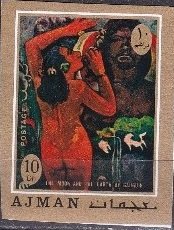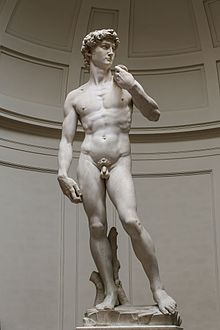Stamp: The Moon and the Earth (1893), by Paul Gauguin (Ajman 1971)
The Moon and the Earth (1893), by Paul Gauguin (Ajman 1971)
21 April (Ajman ) within release Paintings goes into circulation Stamp The Moon and the Earth (1893), by Paul Gauguin face value 10 United Arab Emirates dirham
| Stamp The Moon and the Earth (1893), by Paul Gauguin in catalogues | |
|---|---|
| Michel: | Mi: AJ 831B |
Stamp is square format.
Also in the issue Paintings:
- Stamp - Spring by Bocklin face value 1;
- Stamp - Fortune by Reni face value 2;
- Stamp - Giovanni Bellini face value 3;
- Stamp - Vanity by Baldung face value 4;
- Stamp - The love and the time by Bronzino face value 5;
- Stamp - The moon and the earth by Gaugin face value 10;
- Stamp - The Moon and the Earth (1893), by Paul Gauguin face value 10;
- Stamp - Allegory of Music (1529), by Hans Baldung face value 2;
- Souvenir Sheet - Allegory of the Treasures of the Sea (1585) by Jacopo Zucchi face value 10;
- Stamp - Prudence (1529), by Hans Baldung face value 4;
- Stamp - Fortune (1637), by Guido Reni face value 2;
- Stamp - Venus, Cupid, Folly and Time (1545), by Bronzino face value 5;
- Stamp - Spring (1862), by Arnold Böcklin face value 1;
- Stamp - Prudence (c. 1490), by Giovanni Bellini face value 3;
- Souvenir Sheet - Allegory of the Treasures of the Sea (1585) by Jacopo Zucchi face value 10;
- Stamp - Allegory of Music (1529), by Hans Baldung face value 2;
- Stamp - Saturn, Conquered by Amor, Venus and Hope, by Simon Vouet face value 3;
- Souvenir Sheet - Olympia, by Edouard Manet face value 10;
- Mini Sheet - Paintings face value 25;
- Stamp - Olympia, by Edouard Manet face value 10;
- Stamp - Allegory of the Treasures of the Sea (1585) by Jacopo Zucchi face value 10;
Stamp The Moon and the Earth (1893), by Paul Gauguin it reflects the thematic directions:
Art is a diverse range of human activities in creating visual, auditory or performing artifacts (artworks), expressing the author's imaginative or technical skill, intended to be appreciated for their beauty or emotional power. In their most general form these activities include the production of works of art, the criticism of art, the study of the history of art, and the aesthetic dissemination of art. The oldest documented forms of art are visual arts, which include creation of images or objects in fields including painting, sculpture, printmaking, photography, and other visual media. Architecture is often included as one of the visual arts; however, like the decorative arts, or advertising, it involves the creation of objects where the practical considerations of use are essential—in a way that they usually are not in a painting, for example. Music, theatre, film, dance, and other performing arts, as well as literature and other media such as interactive media, are included in a broader definition of art or the arts. Until the 17th century, art referred to any skill or mastery and was not differentiated from crafts or sciences. In modern usage after the 17th century, where aesthetic considerations are paramount, the fine arts are separated and distinguished from acquired skills in general, such as the decorative or applied arts.
Eroticism (from Ancient Greek ἔρως (érōs) 'love, desire' and -ism) is a quality that causes sexual feelings, as well as a philosophical contemplation concerning the aesthetics of sexual desire, sensuality, and romantic love. That quality may be found in any form of artwork, including painting, sculpture, photography, drama, film, music, or literature. It may also be found in advertising. The term may also refer to a state of sexual arousal or anticipation of such – an insistent sexual impulse, desire, or pattern of thoughts.
The nude, as a form of visual art that focuses on the unclothed human figure, is an enduring tradition in Western art. It was a preoccupation of Ancient Greek art, and after a semi-dormant period in the Middle Ages returned to a central position with the Renaissance. Unclothed figures often also play a part in other types of art, such as history painting, including allegorical and religious art, portraiture, or the decorative arts. From prehistory to the earliest civilizations, nude female figures were generally understood to be symbols of fertility or well-being.
Painting is the practice of applying paint, pigment, color or other medium to a solid surface (support base). The medium is commonly applied to the base with a brush, but other implements, such as knives, sponges, and airbrushes, can be used. Painting is a mode of creative expression, and the forms are numerous. Drawing, gesture (as in gestural painting), composition, narration (as in narrative art), or abstraction (as in abstract art), among other aesthetic modes, may serve to manifest the expressive and conceptual intention of the practitioner. Paintings can be naturalistic and representational (as in a still life or landscape painting), photographic, abstract, narrative, symbolistic (as in Symbolist art), emotive (as in Expressionism), or political in nature (as in Artivism). A portion of the history of painting in both Eastern and Western art is dominated by spiritual motifs and ideas. Examples of this kind of painting range from artwork depicting mythological figures on pottery, to Biblical scenes rendered on the interior walls and ceiling of the Sistine Chapel, to scenes from the life of Buddha or other images of Eastern religious origin. In art, the term painting describes both the act and the result of the action. The support for paintings includes such surfaces as walls, paper, canvas, wood, glass, lacquer, clay, leaf, copper and concrete, and the painting may incorporate multiple other materials including sand, clay, paper, plaster, gold leaf, as well as objects. The term painting is also used outside of art as a common trade among craftsmen and builders.



